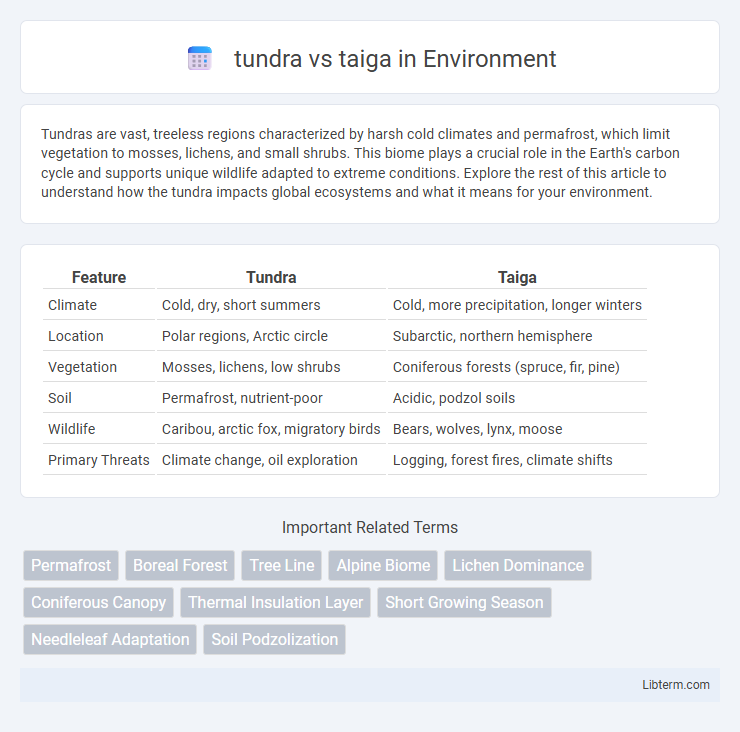Tundras are vast, treeless regions characterized by harsh cold climates and permafrost, which limit vegetation to mosses, lichens, and small shrubs. This biome plays a crucial role in the Earth's carbon cycle and supports unique wildlife adapted to extreme conditions. Explore the rest of this article to understand how the tundra impacts global ecosystems and what it means for your environment.
Table of Comparison
| Feature | Tundra | Taiga |
|---|---|---|
| Climate | Cold, dry, short summers | Cold, more precipitation, longer winters |
| Location | Polar regions, Arctic circle | Subarctic, northern hemisphere |
| Vegetation | Mosses, lichens, low shrubs | Coniferous forests (spruce, fir, pine) |
| Soil | Permafrost, nutrient-poor | Acidic, podzol soils |
| Wildlife | Caribou, arctic fox, migratory birds | Bears, wolves, lynx, moose |
| Primary Threats | Climate change, oil exploration | Logging, forest fires, climate shifts |
Introduction to Tundra and Taiga
Tundra and Taiga are two distinct biomes characterized by their cold climates and unique ecosystems. The Tundra is known for its treeless, flat landscape with permafrost, supporting low-growing vegetation like mosses, lichens, and shrubs, while the Taiga, or boreal forest, features dense coniferous forests dominated by spruce, fir, and pine trees. These biomes are primarily found in the high latitudes of the Northern Hemisphere, with the Tundra located closer to the Arctic Circle and the Taiga stretching across Canada, Russia, and Scandinavia.
Geographic Distribution: Where Tundra and Taiga Are Found
The tundra biome primarily spans the Arctic regions of North America, Europe, and Asia, covering parts of Alaska, Canada, Greenland, and Siberia, characterized by its treeless landscape and permafrost. The taiga, or boreal forest, stretches across a broader belt just south of the tundra, encompassing large portions of Canada, Russia, Scandinavia, and Alaska with dense coniferous forests. These distinct geographic distributions reflect variations in climate, temperature, and soil conditions that influence their respective vegetation and wildlife.
Climate Differences: Tundra vs Taiga
Tundra experiences extremely cold temperatures with long, harsh winters averaging -30degC and short, cool summers rarely exceeding 10degC, while taiga has a subarctic climate with cold winters averaging -15degC and warmer summers reaching 20degC. Precipitation in tundra is low, typically under 250 mm annually, mostly as snow, whereas taiga receives more precipitation, ranging from 300 to 850 mm per year. The tundra's permafrost layer limits soil drainage, causing waterlogged conditions, contrasting with the taiga's well-drained acidic soils supporting dense coniferous forests.
Soil Composition and Characteristics
Tundra soil is typically thin, acidic, and poor in nutrients due to permafrost that limits organic matter decomposition, resulting in a shallow active layer that thaws seasonally. In contrast, taiga soil, or podzol, features acidic, well-drained profiles with humus-rich upper horizons but suffers from slow nutrient cycling due to cold temperatures and coniferous litter. Both ecosystems face limitations in soil fertility, but taiga soils support more extensive forest growth compared to the sparse vegetation of tundra landscapes.
Vegetation: Plant Life Comparisons
The tundra features low-growing vegetation such as mosses, lichens, and dwarf shrubs adapted to harsh, cold climates with permafrost, while the taiga supports dense forests dominated by coniferous trees like spruces, pines, and firs. Plant life in the taiga has deeper root systems and thicker bark to withstand longer growing seasons and colder winters. Unlike the sparse tundra flora, taiga vegetation provides crucial habitats for diverse wildlife and plays a significant role in carbon storage.
Wildlife: Animals of the Tundra and Taiga
The tundra hosts specialized wildlife such as caribou, Arctic foxes, and snowy owls, adapted to extreme cold and short growing seasons. The taiga, or boreal forest, supports diverse species including moose, lynx, and gray wolves, thriving in dense coniferous forests with longer summers. Both biomes feature animals with adaptations for survival, but taiga fauna benefit from greater vegetation diversity and more stable climate conditions.
Seasonal Changes and Adaptations
Tundra experiences extreme seasonal changes with long, harsh winters and short, cool summers, prompting vegetation like mosses, lichens, and low shrubs to develop adaptations such as antifreeze proteins and shallow root systems. Taiga features cold winters and mild summers, fostering dense coniferous forests where trees possess needle-like leaves with waxy coatings to reduce water loss and flexible branches to shed snow. Both biomes exhibit adaptations to cold climates, but taiga plants are generally larger and have deeper roots compared to tundra species, which maximize nutrient uptake in nutrient-poor soils during the brief growing season.
Human Impact and Activities
Human activities in the taiga, such as logging, mining, and oil extraction, significantly impact biodiversity and contribute to habitat fragmentation. In contrast, the tundra faces challenges from climate change-induced thawing permafrost, which disrupts ecosystems and traditional indigenous lifestyles. Both biomes experience increased pressures from resource exploitation, but the taiga endures more direct industrial development due to its dense forest resources.
Ecological Importance and Biodiversity
Tundra ecosystems play a crucial role in carbon sequestration due to their permafrost layers, which store significant amounts of organic carbon and help regulate atmospheric greenhouse gases. Taiga forests, the largest terrestrial biome, support immense biodiversity with vast coniferous tree species and habitat for mammals such as moose, bears, and lynx, contributing to complex food webs and ecosystem stability. Both biomes provide essential ecosystem services including soil formation, climate regulation, and support for migratory species, highlighting their ecological significance despite differing biodiversity levels.
Comparing Challenges and Conservation Efforts
Tundra ecosystems face extreme cold, permafrost, and short growing seasons, limiting biodiversity and making restoration efforts difficult, while taiga regions contend with wildfires, logging, and habitat fragmentation that threaten vast coniferous forests. Conservation efforts in the tundra emphasize protecting fragile soil and preventing industrial encroachment, whereas taiga conservation focuses on sustainable forestry practices and wildfire management to preserve carbon storage. Both biomes require international cooperation and climate change mitigation strategies to address their unique ecological vulnerabilities.
tundra Infographic

 libterm.com
libterm.com